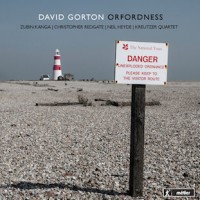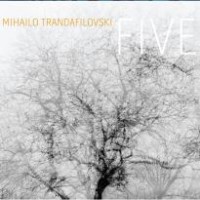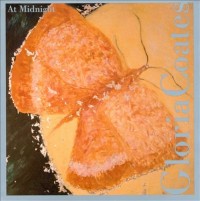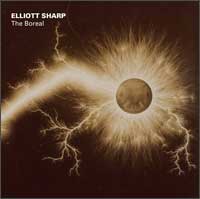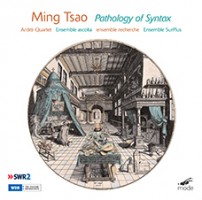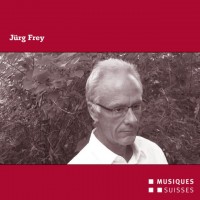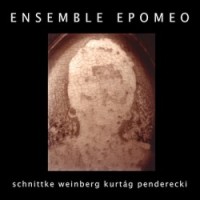String Theory 18: Bundled Quartets and a few Trios
|
Grant Chu Covell [March 2016.]
David GORTON: Orfordness (2011)1; Austerity Measures II (2012)2; Fosdyke Wash (2010)3; 2nd Sonata for Cello (2007)4. Zubin Kanga1,3 (pno), Christopher Redgate2 (Howarth-Redgate ob), Neil Heyde (vlc)4, Milton Mermikides4 (electronics), Kreutzer Quartet2,3: Peter Sheppard Skærved, Mihailo Trandafilovski (vln), Morgan Goff (vla), Neil Heyde (vlc). Metier MSV28550 (1 CD) (http://www.divineartrecords.com/). I imagine that Gorton enjoys a good joke. In the landscape portrait for piano quintet, Fosdyke Wash, a sighing cello part is marked “like distant agricultural machinery.” At that point, the cello sounds like a mewling chainsaw at a far remove. Starting calmly over gently sustained piano pitches (using an ebow), a scordatura quartet (some strings are tuned to different partials) progresses from a gentle fabric of held tones into a chorale suggesting Dowland’s Lachrimae or the descent which closes Strauss’ Alpensinfonie. If Fosdyke Wash is calm, the other works are not. Austerity Measures II chaotically tumbles rambunctious string quartet with the multiphonically inclined Howarth-Redgate oboe. Its abrasive density is built from a combination of pieces: Passacaglia, a violin and cello duo, Cadence, a viola and violin duo, and Gorton’s Third String Quartet (it’s not clear whether Cadence and Passacaglia together do in fact create the Third). The frenetic 2nd Sonata for Cello requires concurrent electronic manipulation of excerpts from the [First] Sonata for Solo Cello where live and recorded cello pile up to create complex simultaneities. Orfordness is another musical landscape portrait. These five movements for piano and tape consider unusual occurrences at Orfordness, a former military base on the Suffolk, UK, coast, where a UFO visit may have occurred. Folded into the piano’s halting music, we hear officers chronicling the “The Rendlesham Forest Incident,” Britain’s so-called Roswell event.
“Five.” Mihailo TRANDAFILOVSKI: Arc-en-ciel (2013)1; Magnets, Lava, Crystals (2011)2; (S)Pacing (2008-09)3; Ripple Effect (2010)4; Chetiri (Four) (2012)5. Peter Sheppard Skærved1, Mihailo Trandafilovski1 (vln), Roger Heaton2 (clar), Kreutzer Quartet2,5, Neil Heyde3, Eve Heyde3 (vlc), Roderick Chadwick4 (pno), New London Chamber Choir5, Adrian Oliver5 (dir.). Innova 914 (1 CD) (http://www.innova.mu/). Trandafilovski is familiar in his guise as a violinist in the Kreutzer Quartet which is featured here in two works, Magnets, Lava, Crystals, a captivating clarinet quintet, and Chetiri (Four), a set of haikus by Macedonian compatriot Vladimir Martinovski. As mentioned in the notes, Scelsi and Radulescu are strong influences. We also hear the spectralist preoccupation with widely spaced chords. Arc-en-ciel is a glinting duet for two violins, a new companion to Scelsi’s composition of the same name, except the tessitura is broader and Trandafilovski has no fear of extended techniques and noise effects. (S)Pacing might be a graduated set of cello duos. Increased techniques suggest pedagogical aims or a progression (difficulty or enlightenment?). Ripple Effect explores the piano’s innate resonance with reverberating chords varying in spacing and range. The instrument is familiar, yet the way the soundboard rings is not. Chetiri (Four) is an atypical chorus plus quartet piece. The strings edge close to noise, bruising tremolo, altogether unexpected harshness. The chorus brings purity with consonant intervals, but sometimes the two dozen masses to suggest the chaos and power of a crowd. The poems explore the four elements, Air, Water, Earth and Fire, reflecting Trandafilovski’s search and discovery of a fundamental, invigorating language.
“At Midnight.” Gloria COATES: Holographic Universe (1975)1; Where the Eagle Flies (1971)2; Among the Asteroids (1962)3; Lunar Loops (1986)4; The Silver Eyed Soul (2008)5. Peter Sheppard Skærved1 (vln), Cambridge University Orchestra1, Neil Thomson1 (cond.), Alessandro Taverna2,5 (pno), Kreutzer Quartet3: Peter Sheppard Skærved, Mihailo Trandafilovski (vln), Morgan Goff (vla), Neil Heyde (vlc); Ruth Fischer4, Stephen Stiens4 (guit), Christine Hoock5 (cbs). Tzadik TZ 8096 (1 CD) (http://www.tzadik.com/). Coates’ titles are deceptive. Her sound world aligns more with Xenakis or Guerrero who preferred single-word enigmatic titles, not poetic labels. Lunar Loops is especially jarring and wondrous. The guitars in this duo retune as they play which produces purring heavyweight chords. Eventually the guitars’ open strings – two sets of six each – arrive at all 12 chromatic pitches. The energetic duo for contrabass and piano, The Silver Eyed Soul, sparks insistent activity, the bass delivering growling tremolo. This release collects pieces and recording sessions that span several decades. The oldest item is a string quartet meant to accompany a stage production of The Little Prince. Stringed instruments superbly express Coates’ microtonal and canonic vision. Holographic Universe contains Coates’ hallmark canons and mammoth glissandos. The solo violin spurs out from the bristling string orchestra with lean gestures reminiscent of Bach and Pärt. The middle movement is a palindrome. Where the Eagle Flies is a piano sonata that explores overtones “and undertones” in four movements: through, around, above and below.
Elliott SHARP: The Boreal (2008)1; Oligosono (2004)2; Proof of Erdős (2006)3; On Corlear’s Hook (2007)4. JACK Quartet1: Christopher Otto, Ari Streisfeld (vln), John Pickford Richards (vla), Kevin McFarland (vlc); Jenny Lin2 (pno), Orchestra Carbon3, David Bloom3 (cond.), Janáček Philharmonic Orchestra4, Peter Rundel4 (cond.). Starkland ST-222 (1 CD) (http://www.starkland.com/). Here are four pieces that hungrily redefine method and structure. The sound world is close to what one may encounter in Xenakis, except that Sharp is more inclined to isolated repetition whereas Xenakis is in constant turbulence. In The Boreal, the string quartet uses non-standard bows: Instead of hair, they might draw springs or tiny metal balls chained together. Ignoring the potential for damage, the sonic effects are mechanical, rasping and inadvertent. In the piano solo Oligosono, pitches are secondary to physical patterns. This rhythmic piece dispatches all prior ways of using a piano. A string orchestra collects for Proof of Erdős which commemorates the itinerant Hungarian mathematician Paul Erdős. Except for acknowledging Erdős’ fearlessness in finding new collaborators, the work’s unsteadiness and coarseness reveal few admirable personal characteristics. On Corlear’s Hook takes its name from an edge of Manhattan on the East River. Not quite a landscape portrait, an orchestra with ample piano and renegade brass engages in erratic motions perhaps reflecting Sharp’s experience of moving from one place to another.
“Pathology of Syntax.” Ming TSAO: Pathology of Syntax (2006-07)1; (Un)cover (2008)2; The Book of Virtual Transcriptions (2004-05)3; Not Reconciled (2002-03)4; One-Way Street (2006)5; Canon (2001)6. The Arditti String Quartet1, Ensemble ascolta2, Jonathan Stockhammer2 (cond.), Ensemble SurPlus3,4, James Avery3,4 (cond.), ensemble recherche5, Anthony Burr6 (clar), Charles Curtis6 (vlc). mode 268 (1 CD) (http://www.moderecords.com/). A first listen reveals well-recorded rasps and clicks, a trampled field after the Lachenmann circus has left town. If there’s music here, it’s obscure. Mode’s website offers succinct descriptions orthogonal to the booklet’s lengthier and impenetrable notes. We learn of Tsao’s preoccupation with older materials, deeply obscured in these derived pieces. Pathology of Syntax, for string quartet, simulates a late Beethoven quartet, impossibly hard to spy. (Un)cover for an appealing but veiled ensemble of trumpet, trombone, piano, guitar, cello and percussion, reflects upon the first movement of Beethoven’s Op. 111. The Book of Virtual Transcriptions considers Mozart’s oboe quintet, K. 370, and the clarinet and cello duo expounds upon Bach’s Musical Offering. I heard these pieces differently after consulting the remarks. After close listening, I grew suspicious of Tsao’s endeavors. Canon, the clarinet and cello duo, sounds nothing like Bach or anything Baroque, and could be as much about Fux or Partch. I devour a lot of contemporary music and an estimable share of the Classics, and the references escaped me. I don’t mind having to listen carefully and puzzle it out. And at the other extreme, I don’t mind a practical joke. It is a strange experience to hear one thing while trying to recall another, and that confused associative experience can be momentarily worthwhile. Hinting at possible allusions forces different listening, however it seems as if Tsao is searching for fish in the sky, even if they are interesting fish.
Jürg FREY: Mémoire, horizon (2013-14)1; Extended Circular Music Nos. 12, 23, 34, 55, 66 and 77 (2011-14); Architektur der Empfindungen (2011-12)8. Mondrian Ensemble: Daniela Müller2,8 (vln), Petra Ackermann2,4,8 (vla), Kaorlina Öhman2,8 (vlc), Tamriko Kordzaia2,3,4,8 (pno); Konus Quartet: Fabio Oehrli1,5,6,7, Jonas Tschanz1,5,6,7, Christian Kobi1,7, Stefan Rolli1,5,6,7 (sax). Musiques Suisses MGB CTS-M 144 (1 CD) (https://www.musiques-suisses.ch/). This portrait disc presents Frey’s recent canonic work realized in slow and gentle pieces of great strength. The half-hour saxophone quartet, Mémoire, horizon, asks for soft chords and tones to appear from nowhere, moving leisurely which obscures the larger structure. We revel in the quartet’s supple long notes and are surprised when triads and familiar chords arrive and then melt away. The Extended Circular Music series offers short but gentle movements containing chords and pitches dispensed gradually which anoint sound and silence equally. They are for various ensembles drawn from piano or saxophone quartet. The quarter-hour Architektur der Empfindungen also proceeds calmly, a pensive and delicate piano quartet spinning out harmonics and pitches. Sections are defined by significant pauses, and then the canons reconfigure to slowly spool out.
Alfred SCHNITTKE: String Trio (1985). Mieczysław WEINBERG: String Trio (1950). György KURTÁG: from Signs, Games and Messages (1989-2005). Krzysztof PENDERECKI: String Trio (1990-91). Ensemble Epomeo: Diane Pascal (vln), David Yang (vla), Kenneth Woods (vlc). Avie AV 2315 (1 CD) (http://www.avie-records.com/). To follow the devastating Schnittke Trio with Weinberg’s takes chutzpah or a mordant sense of humor. Weinberg’s semi-Shostakovich plaintiveness cannot compare with Epomeo’s perfect heartbreaking Schnittke. I have started this disc a number of times only to set down the headphones after the Schnittke. The six Kurtág shards feel surprisingly large. The well-built Penderecki is nonetheless fleeting. Considering the Weinberg and Penderecki together does suggest that Shostakovich looms large. According to the notes, written by cellist (and conductor) Kenneth Woods, this trio came together to play the Schnittke. Their comprehensive dedication to the work shows. Get it for the Schnittke which is huge and ideal here.
[Previous Article:
Soloists Steal Spotlight in Carnegie Hall Concerts]
[Next Article:
(Dis)Arrangements 7: Beethoven]
|
